wheel BUICK REGAL 1994 Owners Manual
[x] Cancel search | Manufacturer: BUICK, Model Year: 1994, Model line: REGAL, Model: BUICK REGAL 1994Pages: 308, PDF Size: 15.78 MB
Page 23 of 308
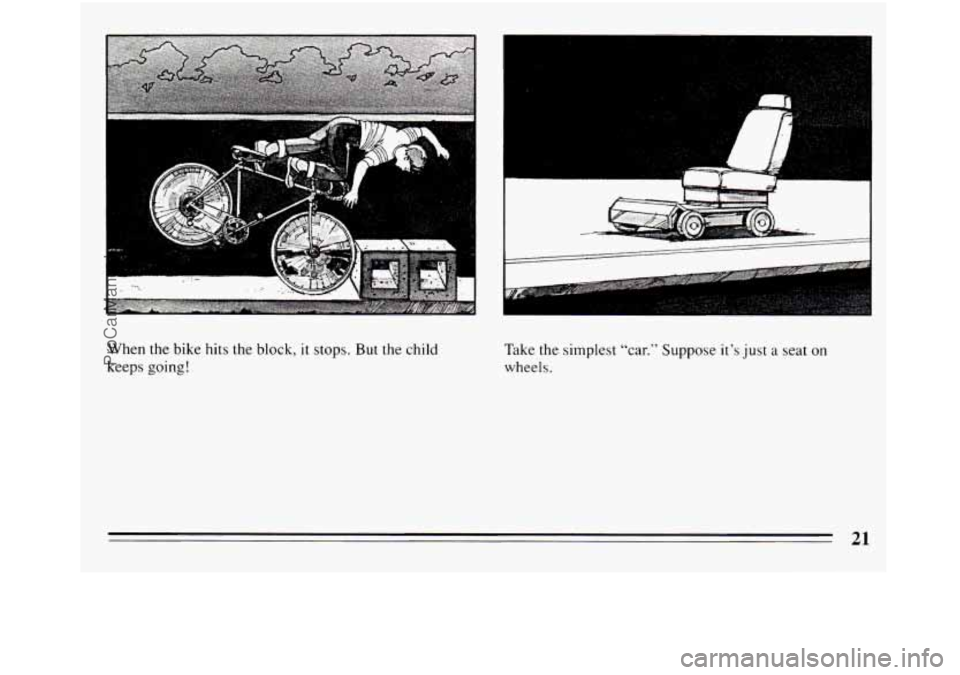
When the bike hits the block, it stops. But the child
keeps eoinrr!
..
Take the simplest “car.” Suppose it’s just a seat on
wheels.
21
ProCarManuals.com
Page 37 of 308
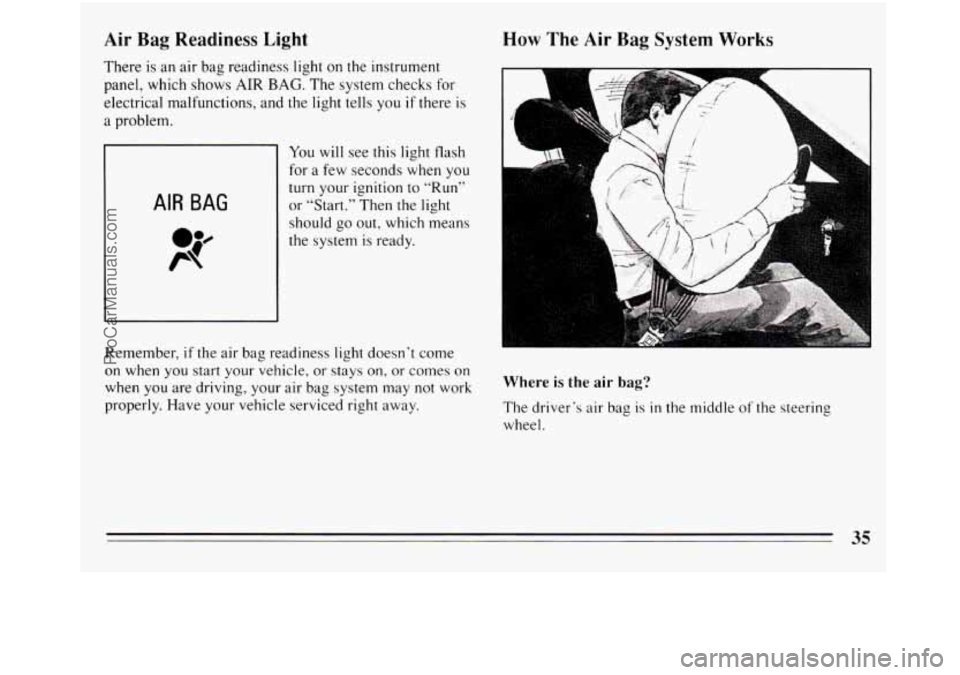
Air Bag Readiness Light
There is an air bag readiness light on the instrument
panel, which shows AIR
BAG. The system checks for
electrical malfunctions, and the light tells you
if there is
a problem.
AIR BAG
You will see this light flash
for a few seconds when
you
turn your ignition to “Run”
or “Start.” Then the light
should go out, which means
the system is ready.
Remember,
if the air bag readiness light doesn’t come
on when you start your vehicle, or stays on, or comes on
when you are driving, your air bag system may not work
properly. Have your vehicle serviced right away.
How The Air Bag System Works
Where is the air bag?
The driver’s air bag is in the middle of the steering
wheel.
35
ProCarManuals.com
Page 38 of 308

When is an air bag expected to inflate?
The air bag is designed to inflate in moderate to severe
frontal or near-frontal crashes. The air bag will only
inflate if the velocity of the impact is above the designed
threshold level. When impacting straight into a wall that
does not move or deform,
the threshold level for most
GM vehicles is between 9 and 15 mph (14 and 23
km/h). However, this velocity threshold depends on the
vehicle design and may be several miles-per-hour faster
or slower. In addition, this threshold velocity will be
considerably higher if the vehicle strikes an object such
as a parked car which will move and deform on impact.
The air bag is also not designed
to inflate in rollovers,
side impacts, or rear impacts where the inflation would
provide
no occupant protection benefit.
In any particular crash, the determination of whether
the
air bag should have inflated cannot be based solely on
the level of damage on the vehicle(s). Inflation is
determined by the angle
of the impact and the vehicle’s
deceleration, of which vehicle damage is only one
indication. Repair cost is
not a good indicator of
whether an air bag should have deployed.
What makes an air bag inflate?
In a frontal impact of sufficient severity, the air bag
sensing system detects that
the vehicle is suddenly
stopping as a result of a crash. The sensing system
triggers a chemical reaction of the sodium azide sealed
in the inflator. The reaction produces nitrogen gas,
which inflates the cloth bag. The inflator, cloth bag, and
related hardware are all part of the air bag inflator
module packed inside the steering wheel.
How does an air bag restrain?
In moderate to severe frontal or near-frontal collisions,
even belted occupants can contact the steering wheel.
The air bag supplements the protection provided by
safety belts. Air bags distribute the force of the impact
more evenly over the occupant’s upper body, stopping
the occupant more gradually. But air bags would not
provide protection
in many types of collisions, including
rollovers and rear and side impacts, primarily because
an occupant’s motion is not toward the air bag. Air bags
should never be regarded as anything more than a
supplement to safety belt protection in moderate to
severe frontal and near-frontal collisions.
36
ProCarManuals.com
Page 39 of 308
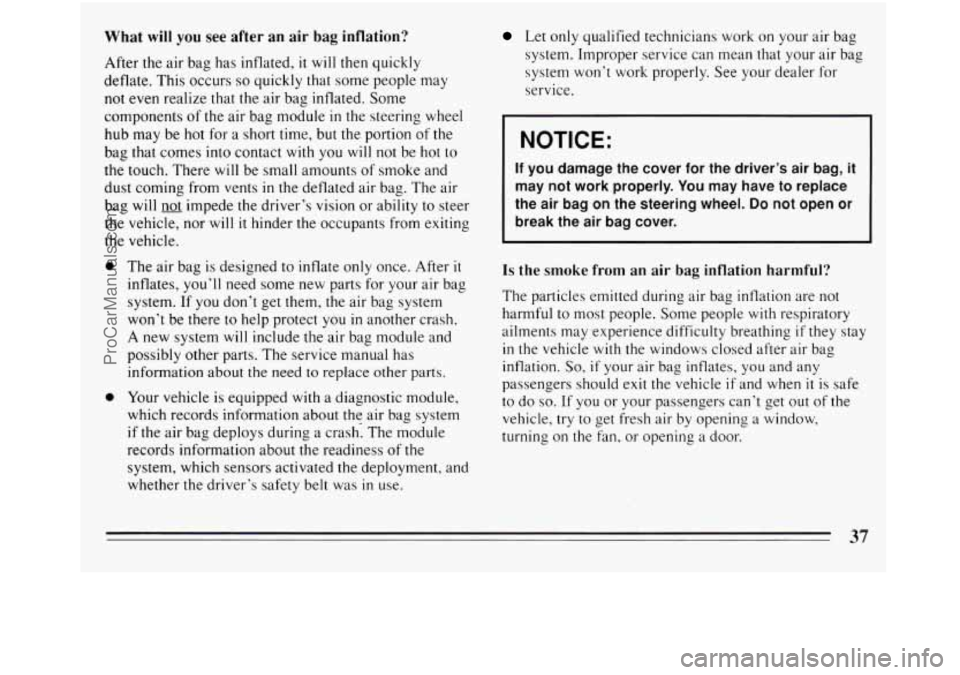
What will you see after an air bag inflation?
After the air bag has inflated, it will then quickly
deflate. This occurs
so quickly that some people may
not
even realize that the air bag inflated. Some
components
of the air bag module in the steering wheel
hub may be hot for a short time, but the portion of the
bag that comes into contact
with you will not be hot to
the touch. There will be small amounts of smoke and
dust coming from vents
in the deflated air bag. The air
bag will
not impede the driver’s vision or ability to steer
the vehicle, nor will
it hinder the occupants from exiting
the vehicle.
0
0
The air bag is designed to inflate only once. After it
inflates, you’ll need some new parts for your air bag
system.
If you don’t get them, the air bag system
won’t be there to help protect you
in another crash.
A new system will include the air bag module and
possibly other parts. The service manual has information about
the need to replace other parts.
Your vehicle is equipped
with a diagnostic module,
which records information about the air bag system
if the air bag deploys during a crash: The module
records information about the readiness of the
system, which sensors activated the deployment, and
whether the driver’s safety belt was
in use.
Let only qualified technicians work on your air bag
system. Improper service can mean that your air bag
system won’t work properly. See your dealer for
service.
NOTICE:
If you damage the cover for the driver’s air bag, it
may not work properly. You may have to replace
the air bag on the steering wheel.
Do not open or
break the air bag cover.
Is the smoke from an air bag inflation harmful?
The particles emitted during air bag inflation are not
harmful to most people. Some people
with respiratory
ailments may .experience difficulty breathing
if they stay
in the vehicle with the windows closed after air bag
inflation.
So, if your air bag inflates, you and any
passengers should exit the vehicle
if and when it is safe
to do
so. If you or your passengers can’t get out of the
vehicle,
try to get fresh air by opening a window,
turning on the
fm, or opening a door.
37
ProCarManuals.com
Page 71 of 308
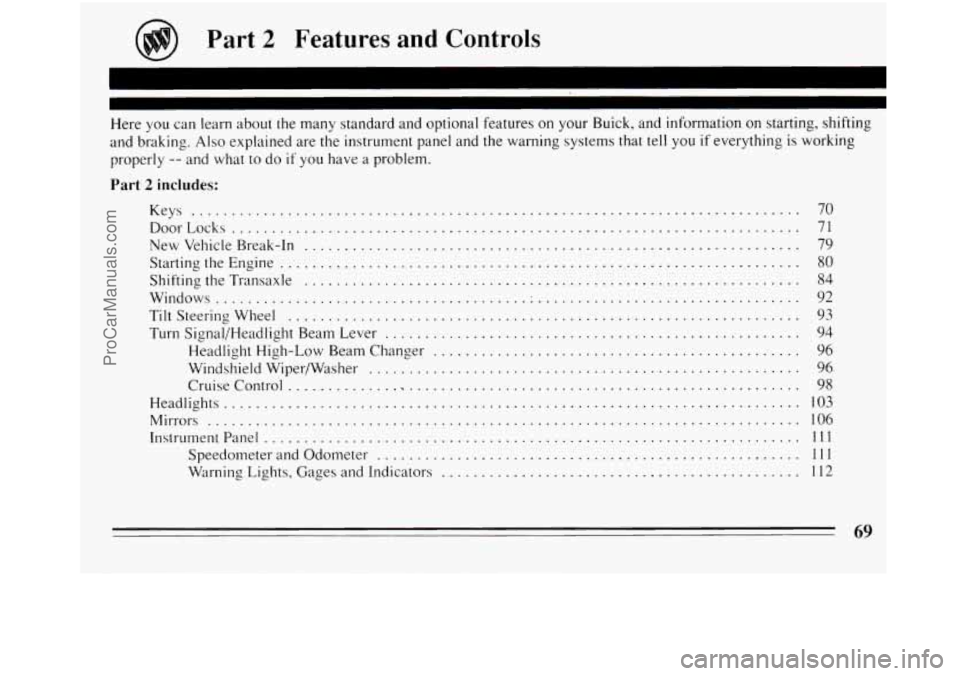
Part 2 Features and Controls
Here you can learn about the many standard and optional features on your Buick. and information on starting. shifting
and braking
. Also explained are the instrument panel and the warning systems that tell you if everything is working
properly
.. and what to do if you have a problem .
Part 2 includes:
Keys ........................................................................\
.... 70
DoorLocks
....................................................................... \
71
NewVehicleBreak-In
.............................................................. 79
StartingtheEngine
................................................................. 80
ShiftingtheTransaxle .............................................................. 84
Windows ........................................................................\
. 92
Turn Signal/Headlight Beam Lever
.................................................... 94
Headlight High-Low Beam Changer
.............................................. 96
Windshield Wipermasher
...................................................... 96
CruiseControl
................................................................ 98
Headlights ........................................................................\
103
Mirrors ........................................................................\
.. 106
Instrumentpanel
................................................................... 111
Speedometer and Odometer ..................................................... 111
Warning Lights, Gages and Indicators
............................................. 112
TiltSteeringWheel
................................................................ 93
69
ProCarManuals.com
Page 79 of 308
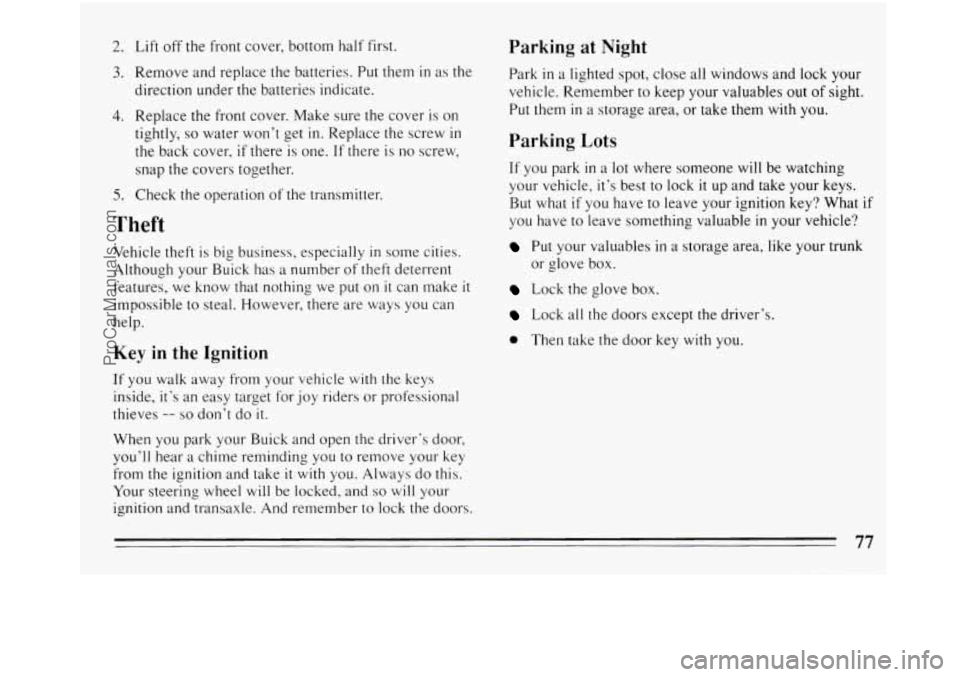
2. Lift off the front cover, bottom half first.
3. Remove and replace the batteries. Put them in as the
direction under the batteries indicate.
4. Replace the front cover. Make sure the cover is on
tightly,
so water won’t get in. Replace the screw in
the back cover, if there is one. If there is no screw,
snap the covers together.
5. Check the operation of the transmitter.
Theft
Vehicle theft is big business, especially in some cities.
Although your Buick has a number of theft deterrent
features, we know that nothing we put on
it can make it
impossible to steal. However, there are ways you can
help.
Key in the Ignition
If you walk away from your vehicle with the keys
inside, it’s an easy target for joy riders or professional
thieves
-- so don’t do it.
When you park your Buick and open the driver’s door,
you’ll hear a chime reminding you
to remove your key
from the ignition and take
it with you. Always do this.
Your steering wheel will be locked, and
so will your
ignition and transaxle. And remember to lock the doors.
Parking at Night
Park in a lighted spot, close all windows and lock your
vehicle. Remember to keep your valuables out
of sight.
Put them
in a storage area, or take them with you.
Parking Lots
If you park in a lot where someone will be watching
your vehicle, it’s best to lock
it up and take your keys.
But what if you have to leave your ignition key? What if
you have to leave something valuable in your vehicle?
Put your valuables in a storage area, like your trunk
or glove box.
Lock the glove box.
Lock all the doors except the driver’s.
0 Then take the door key with you.
77
ProCarManuals.com
Page 82 of 308
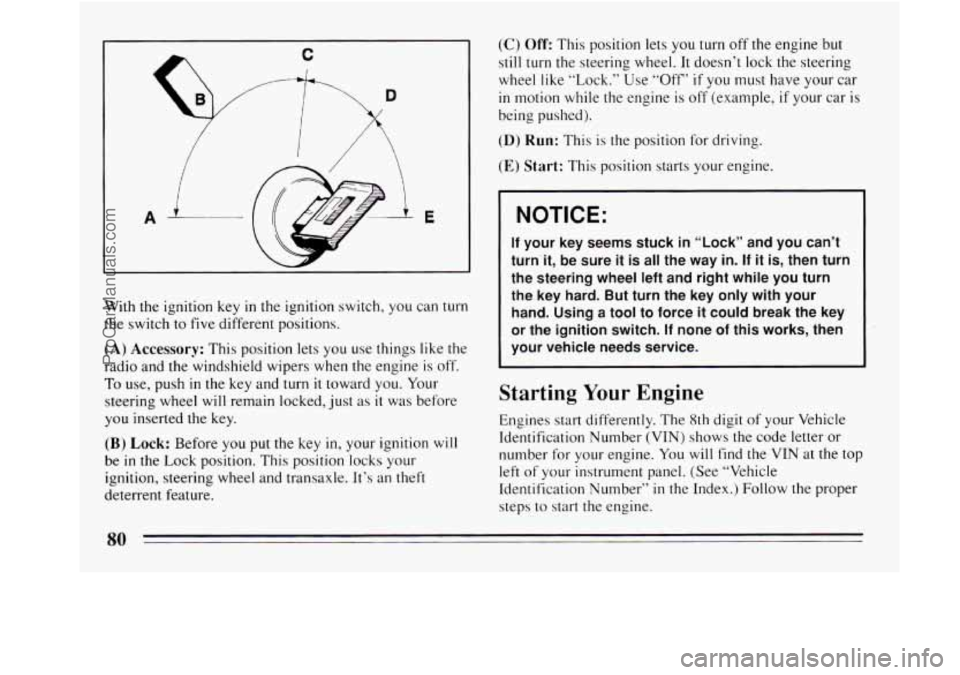
E
With the ignition key in the ignition switch, you can turn
the switch to five different positions.
(A) Accessory: This position lets you use things like the
radio and the windshield wipers when the engine is off.
To
use, push in the key and turn it toward you. Your
steering wheel
will remain locked, just as it was before
you inserted the key.
(B) Lock: Before you put the key in, your ignition will
be in the Lock position. This position locks your
ignition, steering wheel and transaxle. It’s an theft
deterrent feature.
(C) Off: This position lets you turn off the engine but
stili
turn the steering wheel. It doesn’t lock the steering
wheel like “Lock.” Use “Off’
if you must have your car
in motion while the engine is off (example, if your car is
being pushed).
(D) Run: This is the position for driving.
(E) Start: This position starts your engine.
I NOTICE:
If your key seems stuck in “Lock” and you can’t
turn’it, be sure
it is all the way in. If it is, then turn
the steering wheel left and right while you turn
the key hard. But turn the key only with your
hand. Using
a tool to force it could break the key
or the ignition switch. If none of this works, then
your vehicle needs service.
Starting Your Engine
Engines start differently. The 8th digit of your Vehicle
Identification Number (VIN) shows the code letter or
number for your engine. You will find the VIN at the top
left of your instrument panel. (See “Vehicle
Identification Number’’
in the Index.) Follow the proper
steps to start the engine.
80
ProCarManuals.com
Page 86 of 308
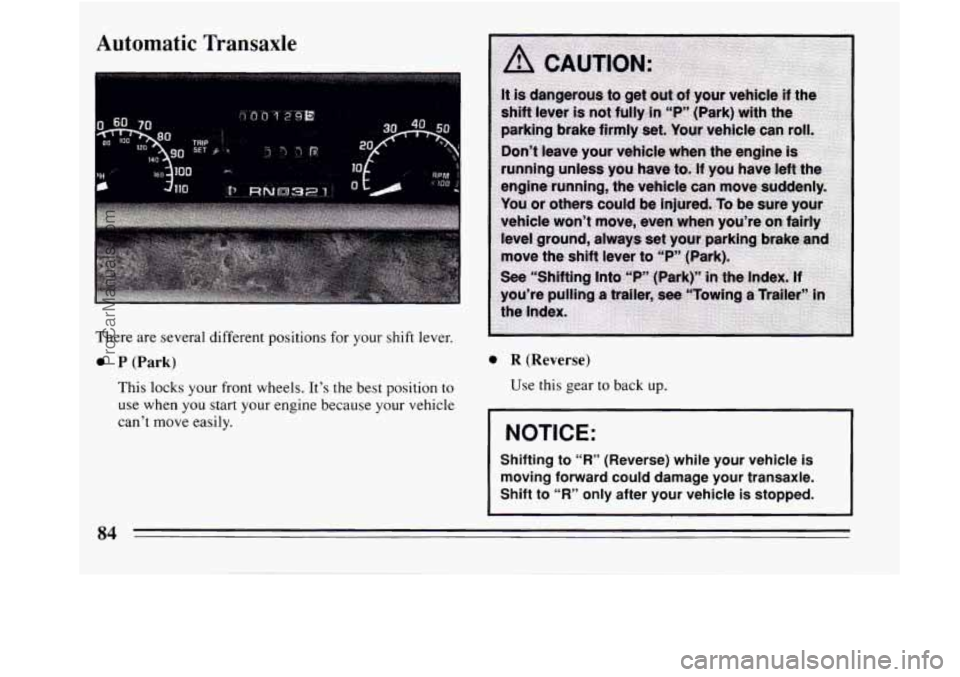
Automatic Transaxle
There are several different positions for your shift lever.
0 P (Park)
This lacks your front wheels. It's the best position to
use when you start your engine because your vehicle
can't move easily.
0 R (Reverse)
Use this gear to back up.
NOTICE:
Shifting to "R" (Reverse) while your vehicle is
moving forward could damage your transaxle.
Shift
to "R" only after your vehicle is stopped.
84
ProCarManuals.com
Page 87 of 308
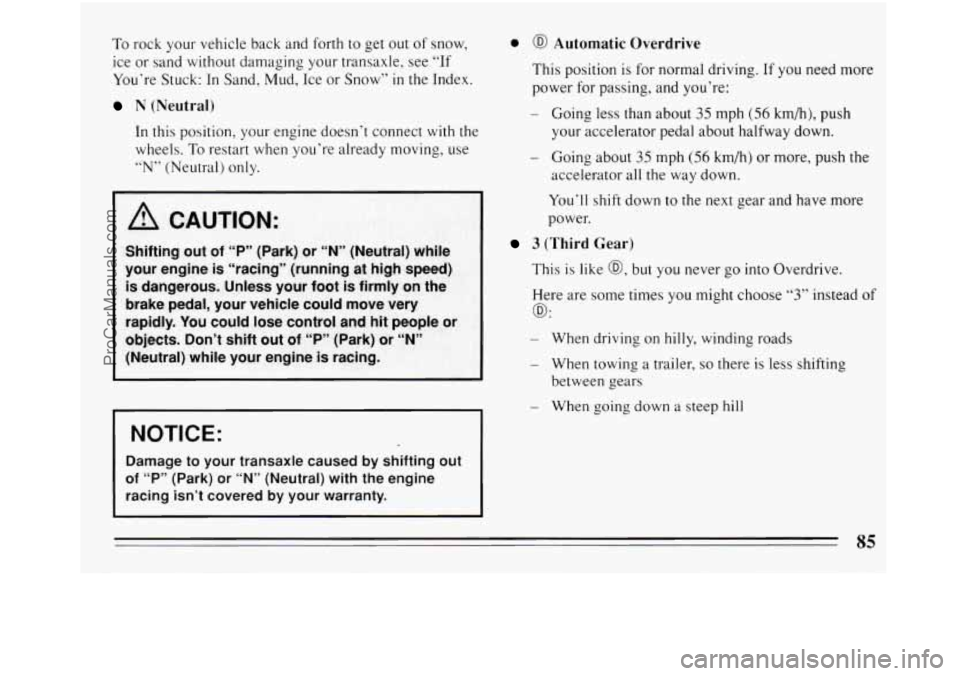
To rock your vehicle back and forth to get out of snow,
ice or sand without damaging your transaxle, see “If
You’re Stuck:
In Sand, Mud, Ice or Snow” in the Index.
N (Neutral)
In this position, your engine doesn’t connect with the
wheels.
To restart when you’re already moving, use
“N” (Neutral) only.
I 6% CAUTION:
NOTICE:
Damage to your transaxle caused by shifting out
of “P” (Park) or “N” (Neutral) with the engine
racing isn’t covered by your warranty.
0 @ Automatic Overdrive
This position is for normal driving. If you need more
power for passing, and you’re:
- Going less than about 35 mph (56 km/h), push
your accelerator pedal about halfway down.
- Going about 35 mph (56 km/h) or more, push the
accelerator all the way down.
You’ll shift down to the next gear and have more
power.
3 (Third Gear)
This is like @, but you never go into Overdrive.
Here are some times you might choose
“3” instead of
@:
- When driving on hilly, winding roads
- When towing a trailer, so there is less shifting
between gears
- When going down a steep hill
85
ProCarManuals.com
Page 88 of 308
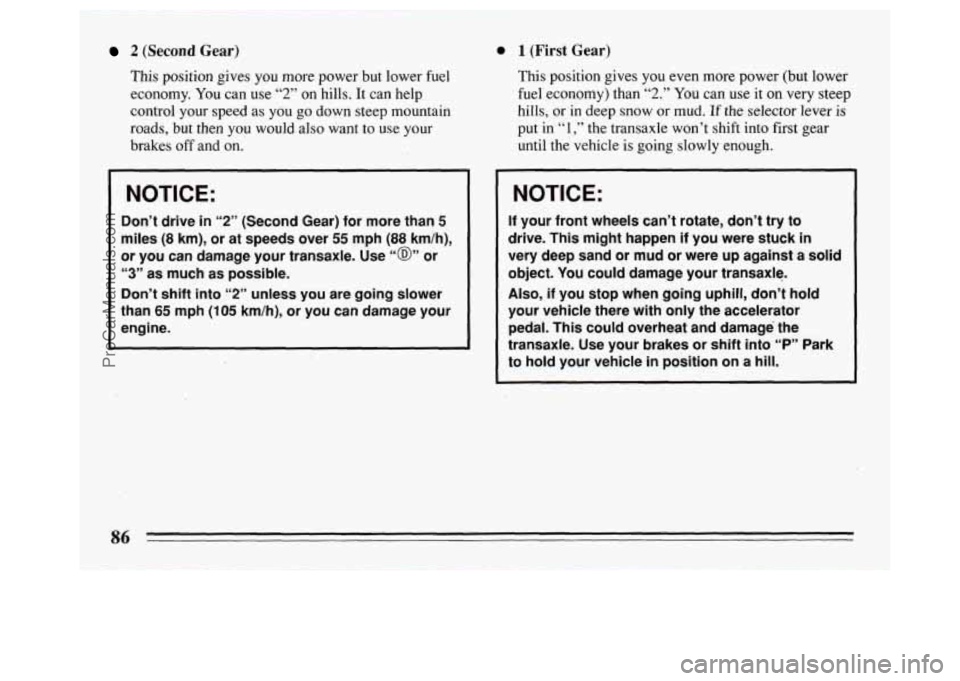
I
I
I
r
2 (Second Gear)
This position gives you more power but lower fuel
economy. You can use
“2” on hills. It can help
control your speed as you go down steep mountain
roads, but then you would also want to
use your
brakes
off and on.
0 1 (First Gear)
This position gives you even more power (but lower
fuel economy) than
“2.” You can use it on very steep
hills, or in deep snow or mud.
If the selector lever is
put in “1,” the transaxle won’t shift into first gear
until the vehicle is going slowly enough.
NOTICE:
Don’t drive in “2” (Second Gear) for more than 5
miles (8 km), or at speeds over 55 mph (88 km/h),
or you can damage your transaxle. Use ‘@” or
“3” as much as possible.
Don’t shift into “2” unless you are going slower
than
65 mph (105 km/h), or you can damage your
engine.
NOTICE:
If your front wheels can’t rotate, don’t try to
drive. This might happen if you were stuck
in
very deep sand or mud or were up against a solid
object. You could damage your transaxle.
Also, if you stop when going uphill, don’t hold
your vehicle there with only the accelerator
pedal. This could overheat and damage the
transaxle. Use your brakes
or shift into “P” Park
to hold your vehicle
in position on a hill.
86
ProCarManuals.com